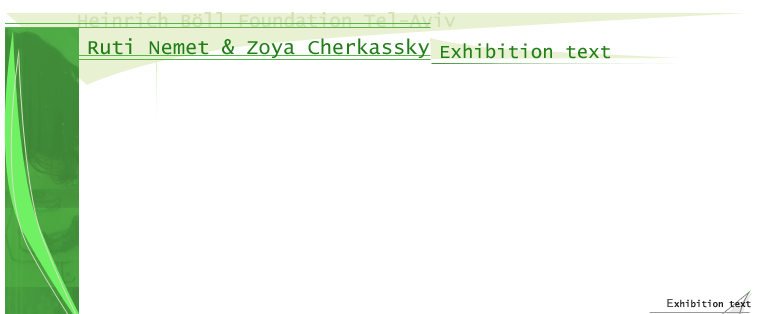


"... A letter of recommendation is, unfortunately, not the genre..." Excerpts from a letter of recommendation for Ruti Nemet and Zoya Cherkassky
Roee Rosen
[...] The large-scale panoramic photograph (six meters in width) is the only work Ruti and Zoya chose to exhibit. It captures, with a single nonchalant closing of the shutter, an engaging, highly detailed sculptural maquette, the result of many months of work. The maquette, whose center is occupied by the artists' self-portraits (two statuettes by Zoya), combines an ironic consciousness, which has thoroughly internalized the tradition of ready-made, with a rare ethos of creativity and fantasy in their most fundamental sense. The portrait, in this case, corresponds not only with the disguised self representation of feminine photography (Cindy Sherman) or with the intense preoccupation in contemporary art with the borderline between representation and reality, animate and inanimate (Mike Kelley). Even the revival of the portrait as an emphatic subject matter in '90s painting cannot encapsulate the range of expression and references inherent in the work. Since every object in the space represented in Not a Bad Size Photograph is charged with narrative and descriptive meaning (every record and book, for instance, are miniaturized models of real, concrete objects), the work likewise corresponds with an entire tradition in the history of art: a tradition of constituting and rendering an identity through the allegorical and symbolic modes (from the Late Renaissance to the Symbolists). In this respect, what may seem to be an ironic act is, at the same time, an expression of belief in the power of art and in the power of the portrait to convey truth and meaning.
Ruti and Zoya's creative contemplation of the representation of space, of scale, and of the portrayal of reality is an intensely profound one. The miniature model is enlarged through the photograph to slightly less than human scale. The ontological disorientation thus experienced by the viewer is disturbing, almost mesmerizing. Unlike the long cultural tradition of scale-shifts (Gulliver, Alice in Wonderland, Charles Ray's sculptures), the viewer's body and consciousness are confronted with figures whose dimensions have indeed changed, yet the nature of that change involves simultaneous expansion and contraction.
Moreover, Ruti Nemet and Zoya Cherkassky charge the possibility of working as a pair (which they do not take for granted) with unique contents. In their case, we are not confronted only with the fusion of two identities into a single creative entity (as in the case of Gilbert and George, The Chapman Brothers, or the Israeli artist team of Aya & Gal), but also with a manifestation of a fascinating dialogue - at times conforming, at others polemical - between two temperaments. This is evident in the postures of the artists' statuettes. While Ruti is sitting at a desk, leafing through a book, with a frontal gaze, Zoya is featured in profile, her hands in a gesture of prayer. Thus, the former assumes a more ironic, rational role, while the latter is inclined toward a metaphysical, faithful, spiritual dimension. The lower belly of the statuette representing Zoya leaves no room for doubt that this is a self-portrait untouched by narcissism. It is a portrait imbued with passion, yet not devoid of self-mockery. The courage manifested by the fact that the assiduous tableau, a sculpture of rare quality, was "subordinated" for the purpose of a single photograph, remaining inaccessible to the viewer's eye, signifies an artistic decision which in itself elicits essential reflections on the creative process. The rich text produced by this work, of its own as it were, generates neither dryness nor fastidiousness. On the contrary: we are dealing with an accessible, experiential work abounding with humor and effervescence.
Not a Bad Size Photograph is not a one-time insight, but rather part of a continuous activity, which I was lucky enough to encounter as a teacher of both artists at the Art Teachers' Training College (I say "lucky" since this is one of those cases where the teacher finds himself enriched by the encounter no less than the students) [...] A letter of recommendation is, unfortunately, neither the literary nor the critical genre which can do these works justice. […]
 |
|
|||
|
|
|
|
||
|
|
|
 |
|
|
|
|
|
|||
|
|
 |
|
||